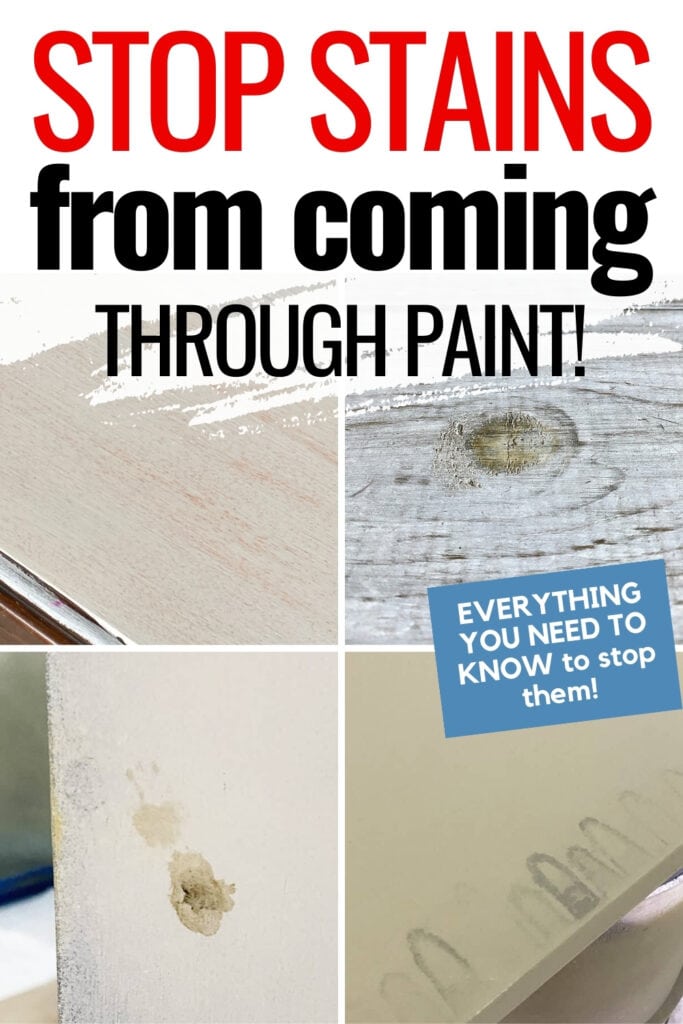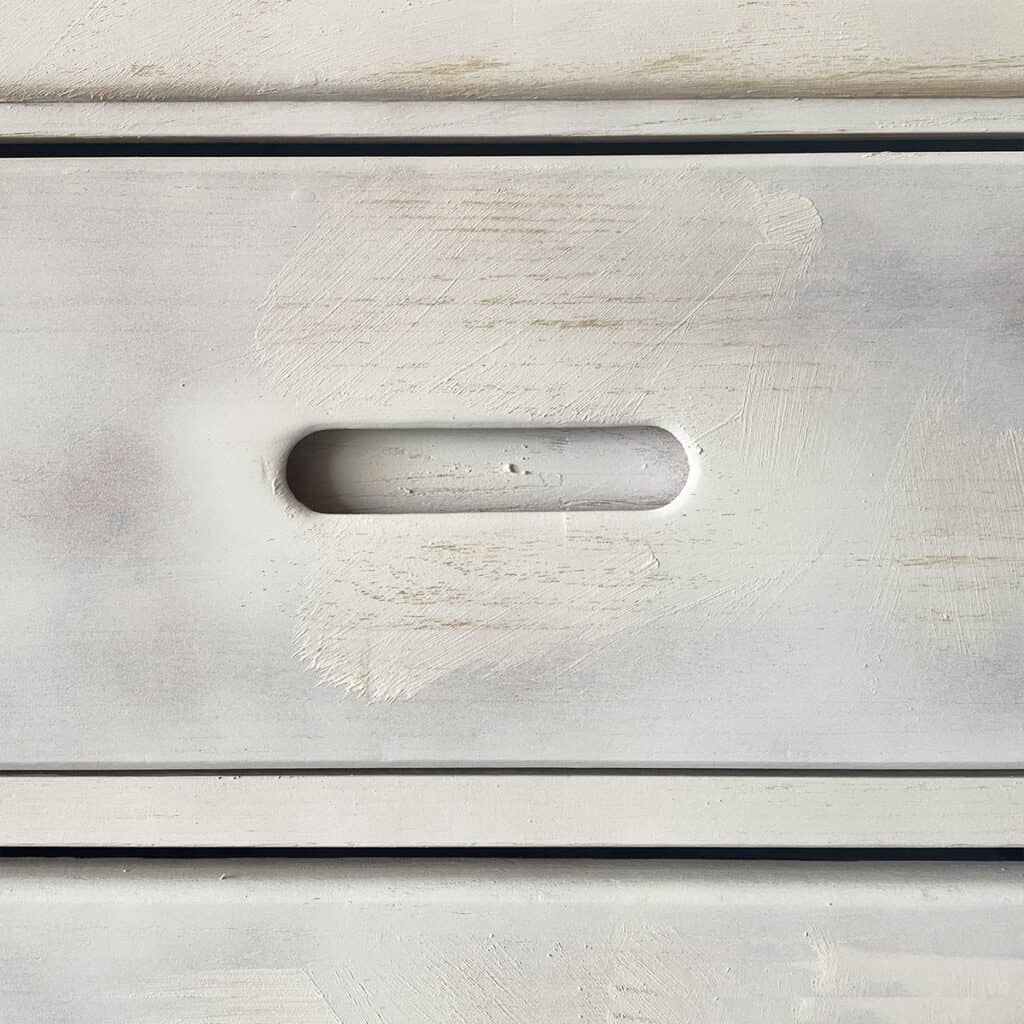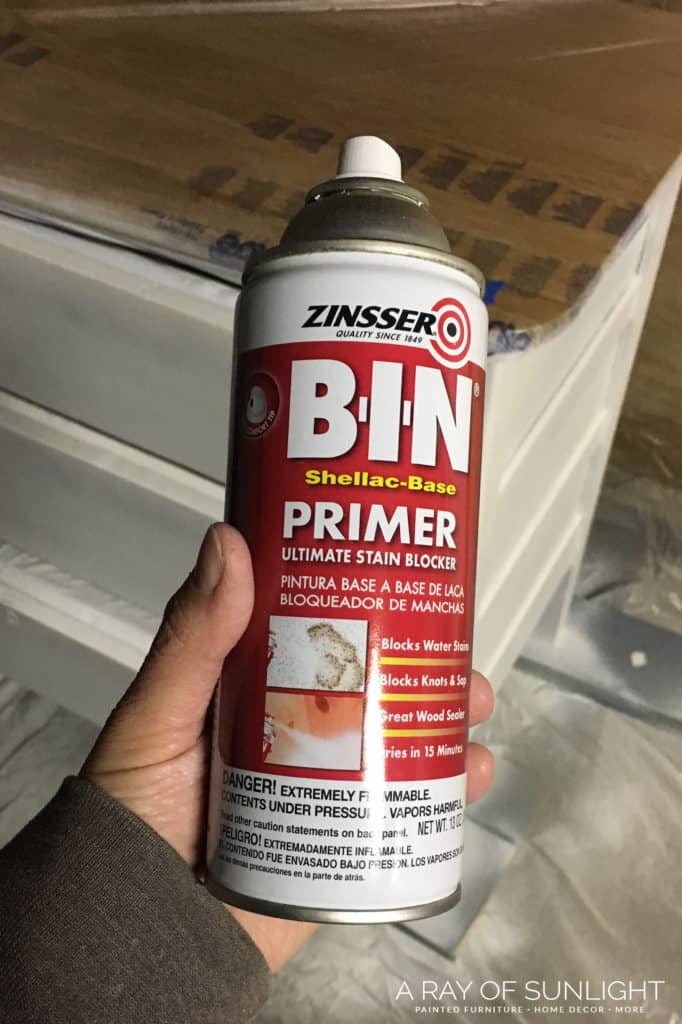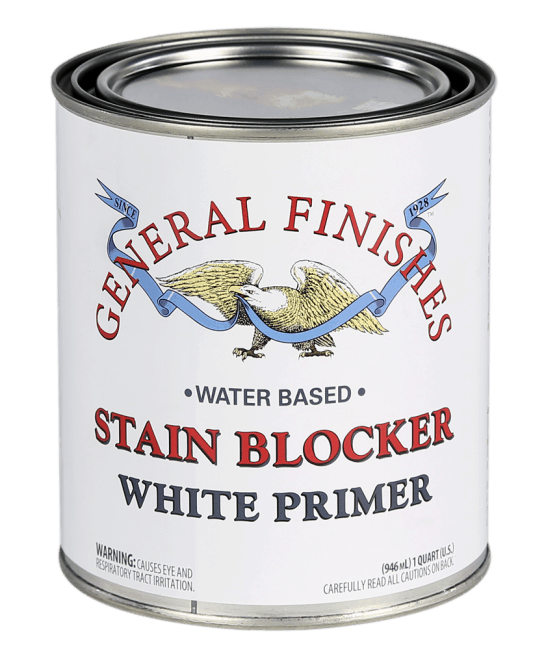How to Stop Stains from Coming Through Paint
Stop painting over “stains” on your painted furniture. Learn how to stop stains from coming through paint, before or after you’ve painted your furniture (or your wooden walls). A yellow stain coming through white paint, or any color stain coming through any color of paint, is called bleed through. It’s annoying, but keep reading to learn how to fix paint bleed through, and how to prevent it from happening the next time.
Get more painting techniques for furniture here!

Bleed through. A word I never heard of until a few months into my painting career.
And then BAM, it was all over, and I had to completely start over on my freshly painted dresser. It was a disaster!
If you’re struggling with a stain that keeps bleeding through paint on the wall, or on any white or light paint, keep reading because we’re going to get it fixed.
Supplies Used to Stop Stains from Coming Through Paint
As an Amazon Associate, I earn from qualifying purchases. I also may earn from other qualifying purchases with other companies or get free product to review and use. All opinions are my own.
- Shellac
- BIN Shellac
- General Finishes Stain Blocking Primer
- Kilz Restoration Primer
- Zinsser 123 Primer
- Respirator
- Roller
- Brush
What Does Bleed Through Look Like?
In simple terms, bleed through acts like a stain that shows up on your painted wood. It tends to look orange or red, and it will not go away, no matter how many coats of paint you put over it.

What Causes Paint to Bleed Through?
In more complicated terms, bleed through is caused by tannins in the wood.
If the tannins aren’t sealed in, they seep through paint, or worse, they don’t show up until you have topcoated your paint with some waterbased poly.
OR they can even take their time and show up weeks after you have painted the wood.
*insert ugly crying face here*
I got you though!
Whether you already painted your piece and you’re just finding out about bleed through on wood furniture, or you haven’t even started your painted furniture project, I have just the fix!
You have to block the bleed through with the right primer!
When Does Bleed Through Most Likely Show Up?
Bleed through is the biggest pain on lighter colors of paint. If you’re painting with a dark color like black, you might not see it because the dark pigments do a good job of hiding the bleed through.
That happened with one of these dark grey painted dressers. That doesn’t mean that it’s not there though.

Bleed through also shows up in wood knots and places where the old finish has been removed down to bare wood. Learn more about how to stop wood knots from bleeding through paint here.
How Can Bleed Through Be Avoided?
The best way to not get stung by bleed through is to prevent bleed through from happening in the first place with a coat or two of stain blocking primer.
Check out the best primers to stop tannin bleed here.
I’ll be honest, when I first learned about bleedthrough I thought that I would just treat it as it happened. But it kept happening so frequently that I wasted so much time going back and fixing it.

So, I promised myself that I would never move forward with a piece without preventing it first.
How to Prevent Bleed Through on Painted Wood Furniture
There are a couple of ways to prevent it, and I choose from the different options depending on the finish I’m going for, or the environment that I’m in.
This step of preventing the bleedthrough on painted wood is like the middle of a sandwich. It’s after I prep the furniture for paint, but before I actually paint any color on.
First, I prep by cleaning the furniture, lightly scuff sanding, and then cleaning the dust off. (Things like permanent markers can bleed through paint too!)
Learn exactly how to prep furniture for paint here and learn more about the importance of sanding before painting furniture here.
Once the prep work is done, I apply 2 coats of my choice of primer below. Check out the best primers for painting furniture here.
Two full coats are really the minimum I would ever recommend using to prevent bleed through. Then you can paint your furniture, and you shouldn’t have bleed through stains anymore.
Related: Don’t make these other five biggest furniture painting mistakes!
Shellac
My first choice is usually shellac. It dries clear, making it a really great way to prevent bleed through if you want to distress the paint on top of it.
It also comes in a spray can, so the application is super easy and fast.
How to Use Clear Shellac to Prevent Bleed Through
When using shellac, I let it dry for at least an hour between coats, longer if you can wait. The longer it dries, the more effective it will be (to a point).
Clear shellac comes in a regular can too, and can be brushed or rolled on. But they will need to be cleaned with ammonia if you want to keep them for another project.
The biggest downside to shellac is that it really really stinks and it’s flammable. So I only use shellac when I can paint outside and I definitely wear a respirator or face mask to protect my lungs.
Pros:
- Dries clear
- Dries quickly
- Cheapest option
- Comes in a spray can for easy application
- Shellac also helps with adhesion
Cons:
- Has a very strong smell
- Flammable
- I recommend 3 coats of shellac
- Works really well with chalk paint and mineral paint… But not all paints
Furniture Makeovers Using Clear Shellac
- Coffee Table Makeover Idea
- Painted Cedar Chest Makeover
- Vintage Dresser Painted with Teal Furniture Paint
BIN Shellac-Based Primer
BIN shellac is a white primer that is shellac based. This one is really good for pieces that I’m painting white, or if I don’t plan on distressing the colored paint.
It covers really well and makes it so you don’t have to use as many coats of white paint, which is a huge plus because painting white can take 5 coats sometimes.
Learn about painting furniture white to get a perfect finish.
I also really love that it comes in a spray can as well, and it acts pretty similar to the clear shellac. It also is one of the best bonding primers for painting furniture!
How to Use BIN Shellac Based Primer to Prevent Bleed Through
When using BIN shellac based primer, I let it dry for at least an hour between coats, longer if you can wait. The longer it dries, the more effective it will be (to a point).
I also like to prime with 2 coats for the best stain blocking powers. Sometimes it needs more.
The downside again, just like the clear shellac is that it’s very stinky and flammable. So I only use it if I am able to paint outside, and I definitely wear a respirator or face mask.
I prefer to use the spray can, but that can get expensive quickly. The next best way is to roll it on because it’s so thin. Here are the best rollers for painting furniture.
Pros:
- Dries fast
- Comes in a spray can for easy application
- Cheaper option
- Is great for white painted furniture
- Great adhesion
- Works with ALL paints
Cons:
- Isn’t clear for distressing purposes
- Has a very strong smell
- Flammable
Furniture Makeovers Using BIN Shellac Based Primer
General Finishes Stain Blocking Primer
I started to use General Finishes stain blocking primer when I had to paint inside for the winter. It still has a smell, but the smell is way less potent than shellac, so I feel way more safe using it indoors.
I still wear my respirator with it though, just to be safe. It works really well to block bleed-through in wood, but it only comes in white.
It also costs more than the shellac options, and it doesn’t come in an easy-to-use spray can.
How to Use Stain Blocker to Prevent Bleed Through
The dry time is also longer than with shellac. I believe the can says to let it dry for at least 2 hours, but it’s best practice to let the last coat dry at least overnight so it can really seal in the wood tannins.
It has to be brushed, or rolled, or you can spray it on with a paint sprayer. Here are the best brushes for painting furniture and here are the best HVLP paint sprayers.
One last thing, I have personally had a couple of problems with this primer drying up and clumping in the can before I can use it.
Once it does, it’s nearly impossible to get it all mixed back together. If you can buy it from someone who hasn’t had it sit on their shelf for a while, you’ll be better off.
Pros:
- No strong smell
- Works very well
- Great for white painted furniture
Cons:
- Isn’t clear for distressing purposes
- Takes longer to dry
- Not as cost-effective
- Doesn’t come in a spray can
Furniture Makeovers Using General Finishes Stain Blocking Primer
Other Stain Blocking Primers
There are other stain blocking primers, like Kilz Restoration primer, Zinsser 123 primer, and numerous other waterbased primers that claim that they will block bleed through stains.
Here’s my list of the best water based primers for more information.
Check out my Zinsser Cover Stain Primer Review here to learn more about the pros and cons of this product.
The very best bleed through stain blockers are shellac and oil based primers. (Oil based primers take a long time to dry enough that you can sand them without clogging up your sandpaper.)
Some water based primers can block bleed through, but they honestly aren’t as good as shellac or oil primers. They also need to dry longer to be effective enough.
If you are working with a lot of bleedthrough, then it’s best to just use shellac primer and/or oil primers to block it.
If there is a small chance you’ll have bleed through, the water based primers might block it without an issue.
Check out this video to see what bleed through looks like, and how shellac based primers compare to water based primers. There are so many good tips in this video!
My Favorite Product to Prevent Bleed Through
My first choice is shellac primer in a spray can. I love how easy and quick it is, and I love that it dries clear. BUT, if I can’t paint outside, then I would use the General Finishes Stain Blocker.
And if I’m not using a mineral or chalk based paint, (like painting with Benjamin Moore Advance) I would recommend not using clear shellac… just because it doesn’t always help every paint stick to all surfaces.

It has worked 99% of the time for me though!
How to Get Rid of Bleed Through After You’ve Already Painted
What if you’ve already painted your furniture, but you’re just now seeing bleed through?? Can you paint over bleed through?
I’ve got good news and I’ve got bad news. The good news is that it can be fixed. The bad news is that it’s going to be extra work.
Here’s our list of the best paint for furniture.

If you haven’t sealed the paint yet
If you caught the bleed through before topcoating your painted furniture, it’s super easy! Just pick your choice of stain blocking primer and paint it over the un-sealed paint.
Make sure to use at least 2 coats and let it dry at least the proper time before painting again.
Read this guide about the topcoats for painting furniture to protect your paint.
If you’ve already sealed the paint with polyurethane
If the bleed-through hid until you painted on the water-based poly, don’t fret! (If you used a wax, it needs to be removed before you can lightly sand and prime again. Sorry!)
Let the poly dry completely and then lightly scuff sand the whole piece by hand. (If you don’t want to sand by hand, here are the best sanders for furniture.)
You just want to scuff up the surface of the poly to make sure your stain-blocking primer is going to adhere well.
Once you’ve scuff-sanded and wiped all the dust off, grab your choice of stain-blocking product and paint at least 2 coats, allowing for proper dry time.
Then paint again and apply your poly. Here’s how to apply polycrylic to painted furniture and learn what’s the best polyurethane for furniture here.
Check out this makeover to see how I fixed bleed through after I sprayed a coat of polyurethane on this homemade chalk painted dresser.
It’s definitely not the end of the world, but it may feel like it when you think you’re basically done with your project!
After basically repainting a few pieces after I didn’t prevent bleed through, I stopped taking chances and now I always prep for bleed through.
Need some inspiration for white painted furniture, or white painted dressers? Check out these posts!
More Painting Furniture resources
- What Paint to Use on a Dresser
- Best Painting Furniture Supplies
- How to Chalk Paint Furniture White
- How to Paint Stripes on a Wall Without Bleeding
- Best Way to Paint Furniture
Follow us on YouTube to get more tips for painting furniture.
Or share your project with us on our Facebook Group and be part of our community. See you there!








Love this-thank you so much for the helpful tips, I’ve ever really painted Furniture , but have a couple of pieces in my bedroom I want to paint. Both of them have some sort of finish: not sure if it’s laminate or paper, but it looks like a faux wood grain, with a putty gray finish . They are not the super cheap ready-to- assemble pieces, so the finish is a nicer quality than some. However, I’m not painting directly on wood, so do I still need to worry about bleed through ?
Hey Cassandra! You don’t need to worry about bleedthrough if it’s not wood. Goodluck!!
Oh my! You have created a tutorial that is SO complete! I have an antique desk that was stripped down and oil sealed. I paid $400 for this desk and some guests got too close to it’s from corner too many times and the veneer has pealed and broken on the top corner. I’m going to paint it! I had never heard of any of the products you mentioned so I’m feeling well prepared to do this! At 65, I won’t use it that long but I want to pass it to my granddaughter and I want it done right! I have linked you into my Favorite file so I can do this with courage! Having had cancer last year and a mess of things not healing after, I had a mastectomy in July and will later probably be having the other breast removed so my time is precious and I want SIMPLE and complete steps to finish this piece. I hated the idea of painting it because the two woods used to build it are beautiful but I figure if she wants to strip it that is her choice later. She just finished her 13th year so her tastes may change. Your tutorial is so complete that I have total confidence I can do this! Well done and thank you so much for that! One less thing to keep procrastinating about!
Oh and because she likes “BLING” I’m going to mirror the top surface and hide the chipped veneer. Then I think I will be brave and stencil the front and sides…
Hey Marilyn!
Thank you for the kind comment!
I’m so sorry to hear about your battle with cancer though! You are so good to be thinking about passing your desk onto your grand daughter!
Goodluck with your desk! I’m sure it will be beautiful with the bling on top and the stencils!
Natalie
Can you still distress your piece if you’ve already painted it, noticed the bleed through, and then applied a stain blocking primer on top and then repaint?
Hey Miranda!
You aren’t going to be able to distress if you use a white stain blocking primer under a dark color of paint because you will see the white primer. You can use the clear primers though! That’s what I do.
Hi, Can you use any paint on top of Dixie Belle Boss or does it have to be a Dixie Belle Paint?
Thank you
I have used a few different paints (chalk paint and powdered milk paint) with success.
Hi there!
I’ve had the same issue! I’m using a semi gloss paint now instead of chalk. My question is, I sealed my dark wood cabinet TWICE! I have then put three coats of white semi gloss paint. I can still see very slight bleed through.
Can I put primer over Over the semi gloss, then another coat of semi gloss? Do I need to then put on some kind of top coat?
Thankyou!
Kylie
Hey Kylie!
I’m sorry! I would scuff sand the paint before priming again. If it’s semi gloss latex paint, I would personally add a topcoat to give it added durability.
I have bleed through on my dresser I chalk painted but I kind of like the aged look. Will the bleed through get worse over time? I’ve already done the top coat and was all done then noticed it after it dried. I just don’t want it to get worse.
More than likely the bleed through will get worse overtime. I’m sorry!
Thank you for the painting tips. I redid a dresser and chest of drawers that has a faux wood top & sides. I stained the real wood drawer fronts and trim in a dark walnut. The non-wood top and sides I painted. I used minwax polyurethane oil-based which yellowed badly on the light sand color paint. I read that I should use water based polyacylic next time. Is your advice to use Verathane water based polyurethane instead?
Oh no! I’m sorry! But yeah, oil based poly will definitely yellow.
I have also had some bad luck with polycrylic turning my light colored pieces yellow almost instantly. But I haven’t had any problems with the Varathane waterbased polyurethane!
I primed all kitchen cabinets using Bin -Advanced Primer White (Synthetic shellac/ Water based). After primer, i do see wood tannins (yellowish/pinkish). I have not started the paint yet (Behr’ kitchen cabinet paint – water based).
What can i do to prevent the tannins coming on top of paint ?
I am using airless spray, for easy clean up, I choose’d water based primer/paint.
Honestly, waterbased primers aren’t the best option to block bleed through. You can use the ones mentioned, but they’ll take more coats and you’ll want to let them dry longer in between coats (let dry for a day or two for best results). Shellac based primers are the best! (Not synthetic shellac though).
Best of luck!
Hey Allison,
What primer did you use? You should be able to apply a few coats of one of these primers over the first primer you’ve used. There’s been many times that I’ve primed after I have painted because the bleed through was still coming through.
Thank you for all the tips. Just wondering how soon after painting will you notice bleed through? My painter does not think I need to prime the full wall before painting. It is an older knotty pine room. The knots have been sanded down and are smooth now and just have some sort of clear gloss over them already. I want to change the room to white but am worried you will later see the knots and the orange color come through. He assures me that if we start to see that he will then prime the whole wall instead of just spot priming. Will I be able to see this that early on in the project or will that show up months later? Thank you!
Hey Kathy!
Honestly, in my experience, it can show up instantly, and it can show up months later.
We bought a dresser second hand that has started to show yellow spots on the bottom drawer. We really don’t want to fix the entire dresser (baby due any day now). It’s a shiny white. Do you think the white shellac will help cover the white that has already seeped through?
Hey Stephanie!
Congrats on the baby! If you know what paint was used on the dresser you can fix just the drawer. I would scuff sand it, prime it with BIN shellac primer and then paint it with the same paint that was used on the rest of the dresser. Make sure to let the BIN primer dry at least overnight. And if you see the stain still coming through one coat of BIN, then give it another coat of two of the BIN primer before you paint with the white paint.
Best of luck!
I sanded and painted a dining room wood table. I painted two coats and bleed thru thru marks where I sanded came thru. I put two coats of bin spray then repainted. It still looks terrible. What can I do to get a smooth looking finish with my paint?
Hey Shirley!
I’m sorry you’re having issues. How long did you let the primer dry between coats and before painting again? The longer you leave it, the better it does. But sometimes, some wood just needs a lot of coats of primer and dry time to actually block the bleed through. I’ve heard that you can apply a coat or two of “cover stain” oil based primer as well. Sometimes that combo will finally be able to block it.
Best of luck!!
Hi, I painted a piece with chalk paint and went to seal it, when I learned the hard way the horrors of bleed threw. I first tried poly than chalk protective top coat to learn both are water-based. Can I seal a finished piece with shellac successfully as a top coat? And for future reference, would wax as a top coat prevent bleed through? Thanks a million!
Oh bummer!
You could seal with shellac, but it will turn your paint color amber… and the clear shellac won’t cover the stains. You’ll need to paint over the shellac.
You can still have issues with bleedthrough if you wax too.
Hi, I have an old dresser that I painted 2 coats of chalk paint to and then applied Polycrylic before I noticed the bleed through. Ugh! I took your advice and scuff sanded it and applied Zinsser Bin Shellac, 2 coats. The drawers look great, no bleed through. The top and sides of the dresser still show bleed through. Do I need to apply a 3rd coat? Or even a 4th if it still bleeds through after the 3rd coat? TIA
I’m sorry! But yes, I would apply another coat on those places where the bleed through is still showing. If it still persists, you can try doing a coat of oil based primer. Sometimes, very rarely, it takes a combination of shellac and oil primers to completely block it.